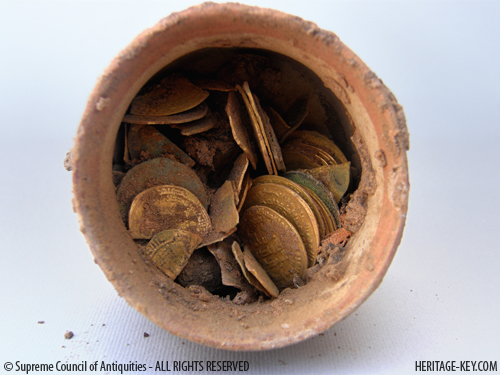 A Polish archaeological team has discovered a decorated clay vessel containing dozens of gold coins at a lost monastery in Egypt. The find was made in a room of the Archangel Gabriel monastery (Deir Malek Gubrail) in Naqlun, in the Fayum Oasis, by the Polish Centre of Mediterranean Archaeology of Warsaw University. SCA chief Zahi Hawass says the hoard’s 18 coins and 62 coin fragments are dated to Egypt’s Abbasid Period, which ruled northern regions between 750 and 1258 AD.
A Polish archaeological team has discovered a decorated clay vessel containing dozens of gold coins at a lost monastery in Egypt. The find was made in a room of the Archangel Gabriel monastery (Deir Malek Gubrail) in Naqlun, in the Fayum Oasis, by the Polish Centre of Mediterranean Archaeology of Warsaw University. SCA chief Zahi Hawass says the hoard’s 18 coins and 62 coin fragments are dated to Egypt’s Abbasid Period, which ruled northern regions between 750 and 1258 AD.
Team leader Wlodzimierz Godlewski says the monastic complex of Naqlun was built at the beginning of the 6th century AD. Yet the hoard, found beneath a collapsed wall, dates to around a hundred years later. A chandelier and lamp, both bronze, were also found at the site.
The monastery was lost to a huge fire between the end of the 8th and beginning of the 9th century AD. Its creation is steeped in myth: according to the legend, an orphaned boy named Oor had a vision of the Virgin Mary and Archangel Gabriel, who told him to build a monastery in the desert.
Christian Monasteries form a little-heralded part of Egyptian culture; forgotten through its rich ancient history. Heritage Key features a video about the restoration of the beautiful Saint Anthony monastery (Deir Mar Antonios) on the Red Sea coast.

It’s been a good year for coin hoards. January saw a massive 824 Roman gold coins unearthed near Wickham Market, Suffolk, England. And September saw an even bigger haul hit the headlines, when 10,000 Roman coins were found near York, England. Both discoveries were made by amateur enthusiasts wielding metal detectors; the same equipment that this year turned up the spectacular Staffordshire and Stirling Hoards – the former recently being valued at 3million-plus.